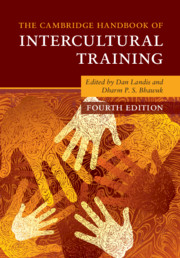Book contents
- The Cambridge Handbook of Intercultural Training
- Reviews
- The Cambridge Handbook of Intercultural Training
- Copyright page
- Dedication
- Frontispiece
- Contents
- Figures
- Tables
- Editors and Contributors
- Foreword
- Preface
- 1 Introduction and Theoretical Framework
- Part I Theoretical Foundations of Intercultural Training
- 2 Harry Triandis’s Contributions to Intercultural Training as a Field of Research
- 3 Interdisciplinary History of Intercultural Communication Studies
- 4 Culture Theories and Intercultural Training
- 5 An Analysis of Methods for Intercultural Training
- 6 Intercultural Simulations
- 7 Toward a Social Network Theory of Reentry
- 8 Intractable Conflict, Delegitimization, and Intercultural Training
- 9 Evaluation of Cross-Cultural Training
- Part II Practice of Intercultural Training
- Part III Indigenous Psychology and Intercultural Training
- Part IV New Interdisciplinary Approaches to Intercultural Training
- Part V Summing Up
- Index
- References
3 - Interdisciplinary History of Intercultural Communication Studies
From Roots to Research and Praxis
from Part I - Theoretical Foundations of Intercultural Training
Published online by Cambridge University Press: 18 September 2020
- The Cambridge Handbook of Intercultural Training
- Reviews
- The Cambridge Handbook of Intercultural Training
- Copyright page
- Dedication
- Frontispiece
- Contents
- Figures
- Tables
- Editors and Contributors
- Foreword
- Preface
- 1 Introduction and Theoretical Framework
- Part I Theoretical Foundations of Intercultural Training
- 2 Harry Triandis’s Contributions to Intercultural Training as a Field of Research
- 3 Interdisciplinary History of Intercultural Communication Studies
- 4 Culture Theories and Intercultural Training
- 5 An Analysis of Methods for Intercultural Training
- 6 Intercultural Simulations
- 7 Toward a Social Network Theory of Reentry
- 8 Intractable Conflict, Delegitimization, and Intercultural Training
- 9 Evaluation of Cross-Cultural Training
- Part II Practice of Intercultural Training
- Part III Indigenous Psychology and Intercultural Training
- Part IV New Interdisciplinary Approaches to Intercultural Training
- Part V Summing Up
- Index
- References
Summary
The process of recording, defining, and narrating the development of any given academic field most often results in an unfortunate reduction and reification of multiple streams, movements, and figures into a single story. The field of intercultural communications faces this challenge to a greater degree, as it involves remembering and recognizing the nuanced roots and unique influences of multiple fields of origin (linguistics, anthropology, psychology, linguistics, communication, education, and more). Recent scholarship has called for re-examining the genealogy of lines traced back to Edward T. Hall to better account for, affirm, and give agency to other perspectives in our complex history. Thus, this chapter seeks to answer the question: “Outside of the mainstream narrative, what are the historical contexts, events, people, places, theories, concepts, processes, and impacts that we cannot afford to forget as a field?” This Bordieuan-guided sociology of knowledge and praxis will be organized into three main areas: (1) influential philosophical thinking on culture and social relations (pre-1900s); (2) comparative and intercultural initiatives that provided conceptualizations, critiques, and applications of social and cultural theory (pre-Hall and pre-1970s); and (3) concurrent parallel tracks that formalized fields of cross- or intercultural studies, which continue to cross-over, contend, and realign to meet the needs of today’s complex cultural contexts (since the 1970s). By approaching the disciplinary history of the field(s) of intercultural studies in an intercultural (multiple-perspectival, reflective, context-sensitive) manner, both revived and new insights are garnered for grappling with and finding new approaches to the important issues facing inter-group relations and intercultural communication research and praxis today.
Keywords
- Type
- Chapter
- Information
- The Cambridge Handbook of Intercultural Training , pp. 60 - 163Publisher: Cambridge University PressPrint publication year: 2020
References
- 8
- Cited by



